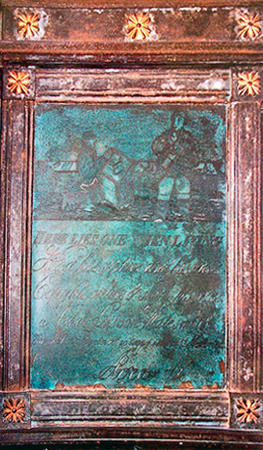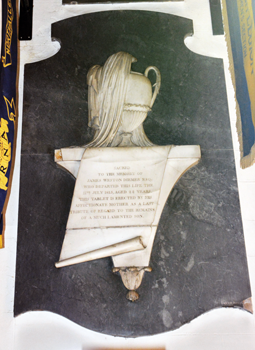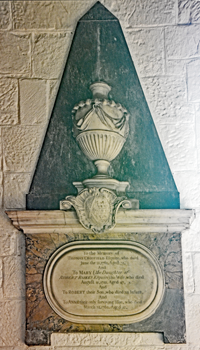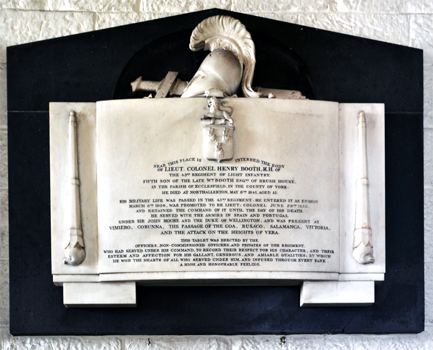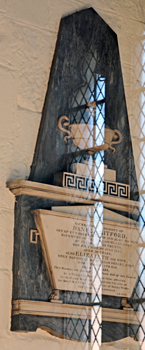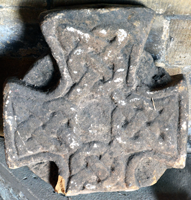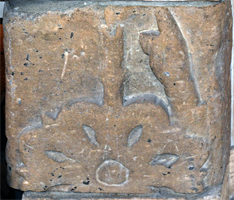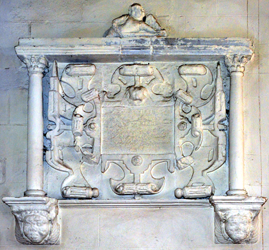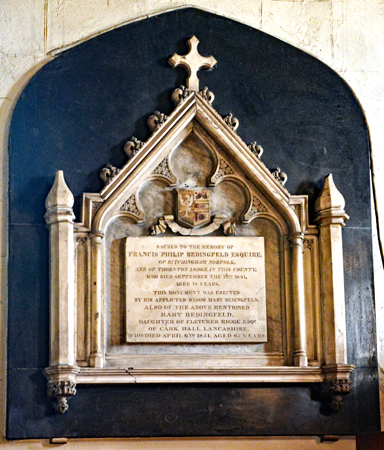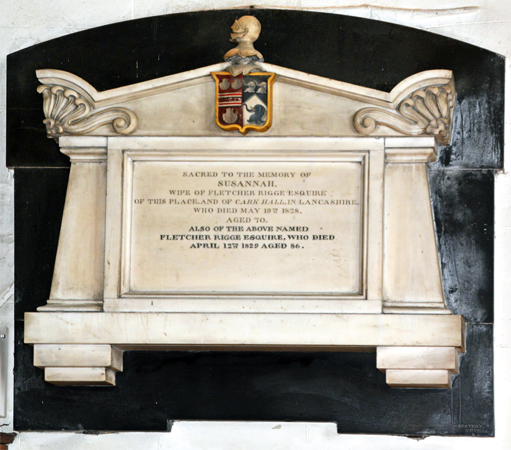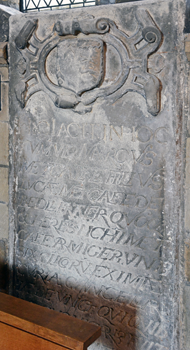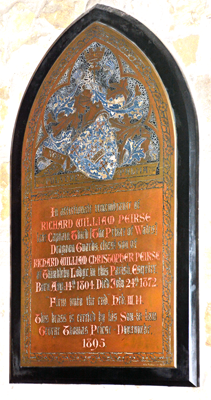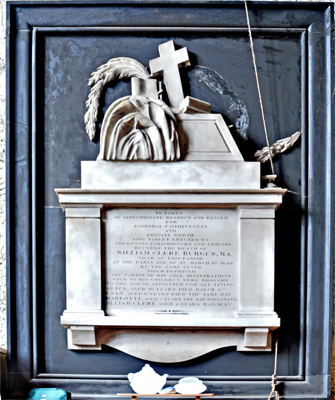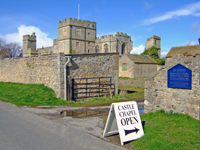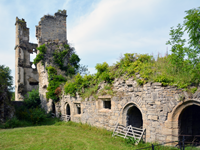| YORKSHIRE - THE NORTH RIDING - 4 |
New Malton Northallerton Nunnington Osmotherley Oswaldkirk Patrick Brompton Pickering Pickhill Richmond Rudby St Gregory's Minster Scarborough Sheriff Hutton Skelton-in-Cleveland Sleights Slingsby Snape Castle South Cowton Spenithorpe Stainton Stanwick Stonegrave Sutton on the Forrest
<Yorkshire North Riding 1> <Yorkshire North Riding 2> <Yorkshire North Riding 3> <Yorkshire North Riding 5>
|
|
|||||||||||||||||
|
||||||||||||||||||
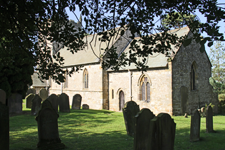 |
Nunnington - All Saints & St James |
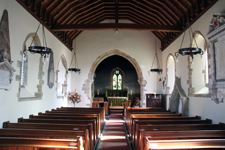 |
| Church open. Park in
the village near church O/S Ref: SE 666 791 |
 |
 |
| Said to be Sir Walter de Teye (1325) |
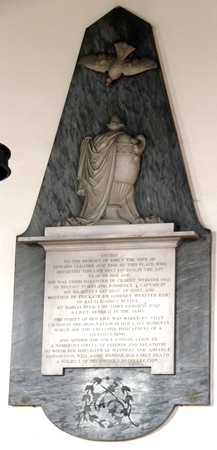 |
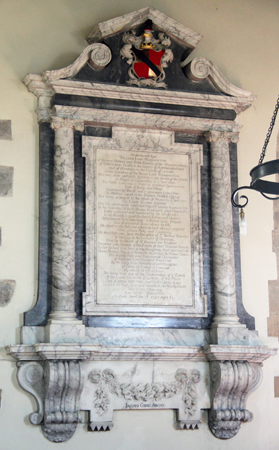 |
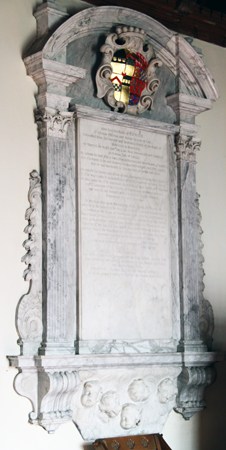 |
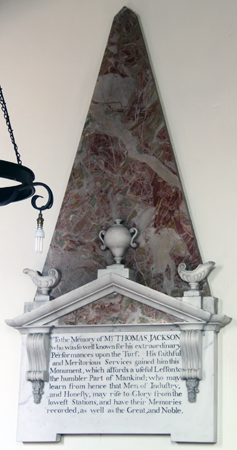 |
|
||||
| Emily Cleaver (1806)
aged 23. By Cleaver |
William, Lord Widdrington (1743) signed Iacobo Gibbs Archi (designed); made by Rysbrack | Richard 1st Viscount Preston (1695) | Thomas Jackson 'who was well known for his extraordinary performance on the Turf' and rose 'from the lowest station' and thereby provided 'a useful Lesson to the humbler Part of Mankind' |
|
|
| Patrick Brompton - St Patrick |
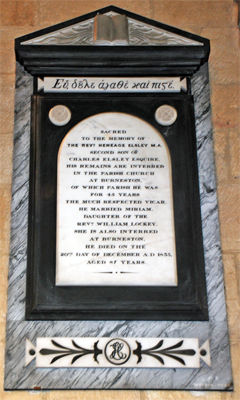 |
 |
 |
| Rev Heneage Elsley MA (1833) Vicar of Burneston 45 years, where he was buried. His wife Miriam was also buried there but no dates are given. Second son of Charles |
George Elsley (1823), His father, Charles Elsley (1761) His grandfather, Gregory Elsley (1749) 'all residence of this village' |
Gregory Elsley (1716) Latin text |
| Pickering - St Peter & St Paul |
|
A church in the centre of
town but open; free parking in the
town nearby NB The section is incomplete: there was building work in progress in the church O/S Ref: SE 799 840 |
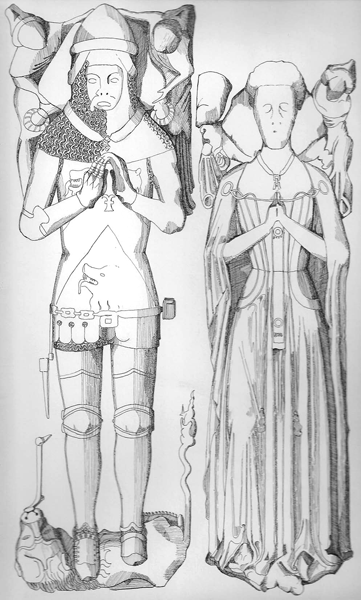 |
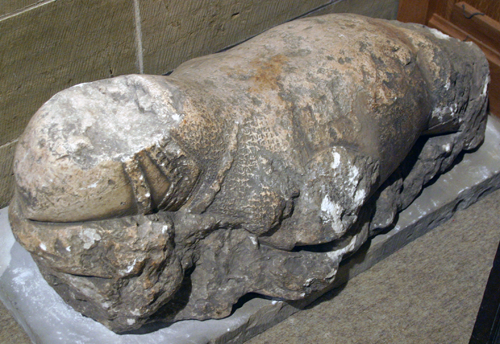 |
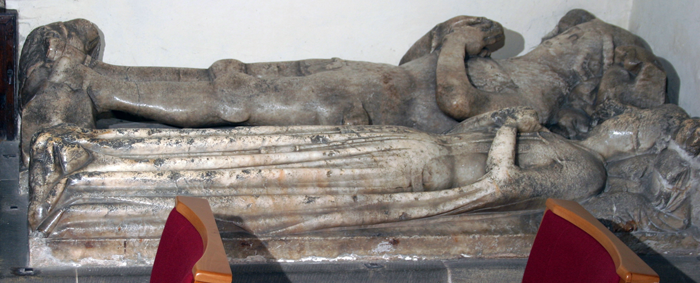 |
|
| Above
left and bottom right: Sir
David and Margery Roucliffe c. 1400.
Alabaster. Note the single chess rook on the
surcoat. In the south
chapel which is now unfortunately locked so I
had to photograph the effigies through the open framework door:
I was unable to take a more satisfactory photograph. I made the
drawing of the effigies (left) in the 1980's Above right top: Alabaster fragment of later 14th century. The repeated pattern of chess rooks around the helmet indicate it may well represent a Roucliffe. Local tradition ascribed it to John of Gaunt , who was actually buried in Old St Paul's, London) The rook is a rebus for the first part of his name |
|
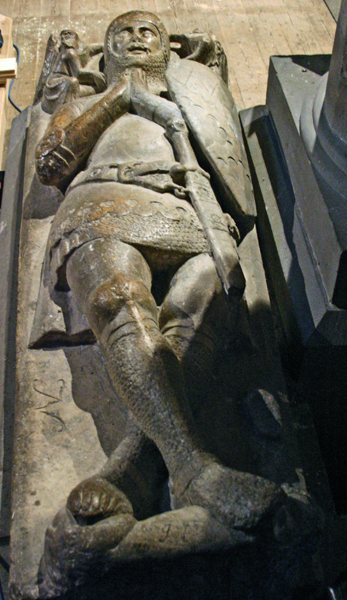 |
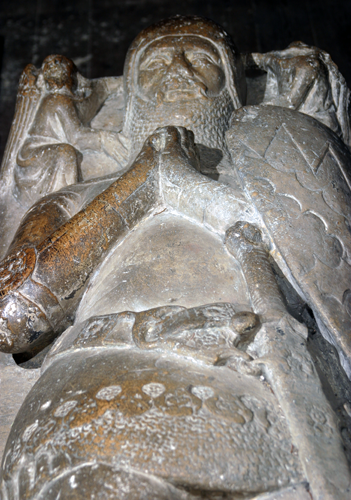 |
| Sir William Bruce who established a chantry in the church in 1337. Note the armour of c. 1340-50 and the arms carved in relief on the shield. |
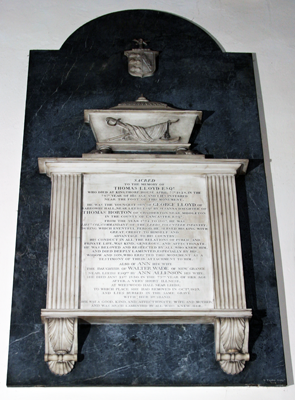 |
 |
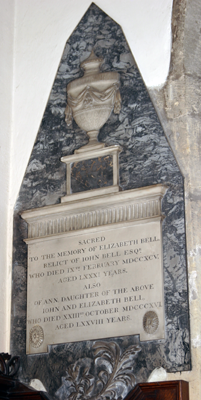 |
 |
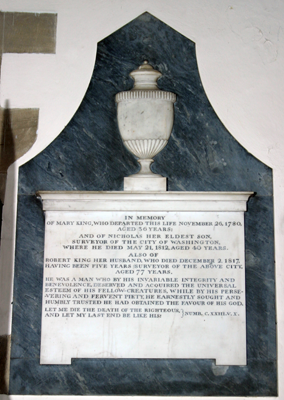 |
| Thomas Lloyd (1828) & Ann (Wade) (1830) | Richard Simpson (1816) & Bithia (1832) | Elizabeth Bell (Robinson) (1795) and daughter Ann (1816) To the right is the monument to her husband and father. | John Bell (1782) and Thomas Robinson (1751) Also two children, Elizth & Sarah 'who both died as infants' | Mary King (1780) and her son Nicholas (1812) 'surveyor of the City of Washington'; also her husband Robert King (1817) 'having been 5 years surveyor of the above city' |
.png) |
Pickhill - All Saints |
.png) |
| Very friendly and welcoming church,
open during daylight hours; keyholder's details given if
visiting outside hours. Good pub in the village. O/S Ref: SE 347 837 |
.png) |
| Sir Andrew Neville (1295) Arms cared in relief on shield but very worn. Appears certainly to have been crossed legged: cf Pevsner who clearly states otherwise. |
 |
.png) |
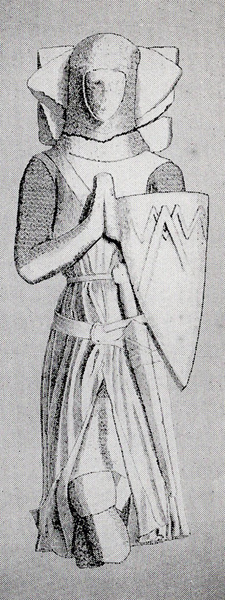 |
|
.png) The other illustrations are of wall monuments and various fragments which include a tomb slab, Anglo-Danish grave covers and part of a hogback tombstone To the right is a drawing of the effigy from I'Anson |
|||
| Richmond - St Mary |
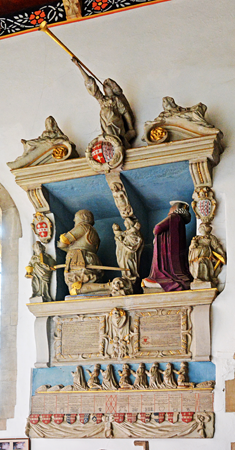 |
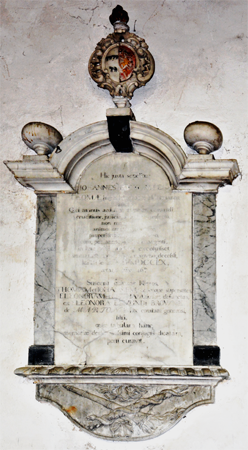 |
 |
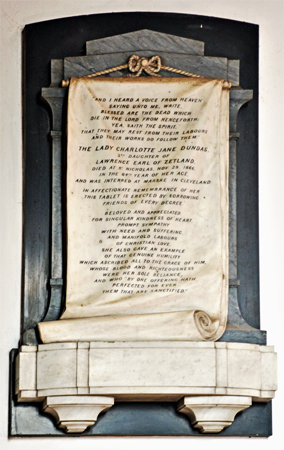 |
|
| Sit Thomas Hutton (1629) Wife and children |
John _ (1740) The rest is now illegible; Latin | Thomas Brooke AM (1739) Rector. Latin text |
Lady Charlotte Jane Dundas (1866) |
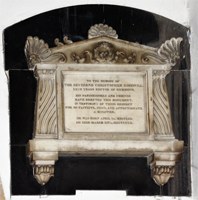 |
 |
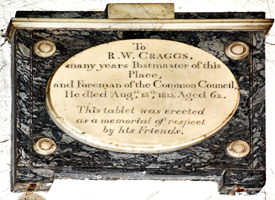 |
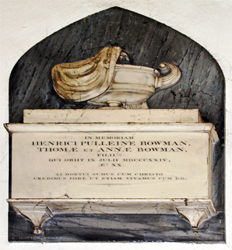 |
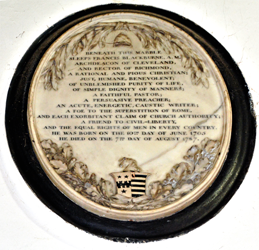 |
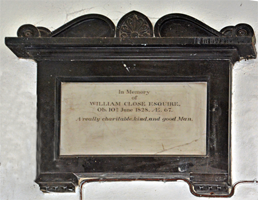 |
|
| Rev Christopher Goodwill (1822) 32 years Rector of Richmond |
George Cuit (1818) 'An
ingenious artist and a very worthy man' And his wife, Jane (1818). Also spelled 'Cuitt' |
R W Craggs (1815) 'Many years Postmaster of this Place' | Henry Pulleine Bowman (1824) | Francis Blackburne AM (1787) Archdeacon of Cleveland Rector of Richmond |
William Close (1825) 'A really charitable, kind and good Man' |
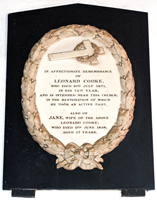 |
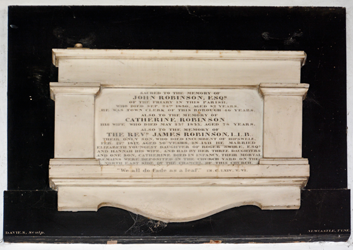 |
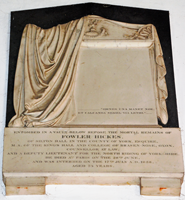 |
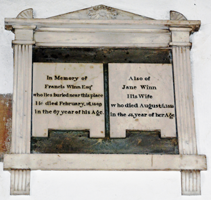 |
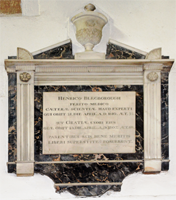 |
|
| Leonard Cooke (1871) 'interred near this church' And his wife, Jane (1858) |
John Robinson(1830); his
wife, Catherine (1833); their only son,
Rev James Robinson (1817) Signed: Davies Sculpt Newcastle Tyne |
Fowler Hicks MA (1838) '...entombed in the vault below repose the mortal remains of...' |
Francis Winn (1809) and his wife Jane Winn (1813) | Henry Blegborough (1810) 'skilled doctor' Latin text His wife, Grace (1807) |
| Other Monuments | |
| Tablets | Brasses |
|
William Wilson (1800) '...remains lie interred at Lewisham near London.' White tablet on black arched base with white dove descending. Signed: Davis Newcastle Thomas Clarkson (1823) 'Serjeant Major and Brother Soldier.' '...erected by the Officers, Non-Commissioned Officers and Privates of the Richman Forester Yeomanry Cavalry...' White tablet on black marble. William Ellis (1816) Banker. White oval tablet on black marble base. Christopher Clarkson FSA (1833) White tablet on black base Wooden tablet with incised gold lettering records that the Regimental Chapel of the Green Howards was renovated 1980 in memory of Mjr-Gen A E Robinson CB DSO JP DL. Col of the Regiment 1949-1959. Walter Alexander (KIA 1915) Lt-Col Commanding 2nd Batt The Green Howards. Dark gray with incised gold lettering. Military badge. Brigadier Hubert Stanley Keyer DSS OBE (1947) and his nephew Cpt Collis Kreyer (1968) of the Green Howards. Gray tablet with military badge Richard Earnshaw Roberts MA (1889) 28 years Rector of Richmond, Rural Dean of Richmond West & Hon Canon of Ripon Cathedral. Granite tablet (?) with gold lettering. Bertram Henry Leatham DSO (KIA 1915) Major The Green Howards. Lt-Col Commanding 2nd Batt Wiltshire Regiment Charles William Gale (1938) Ly and Cpt 1st Batt The Green Howards. Light gray tablet with military badge |
Sarah Margaret Tate (1913) Charles Grey Tate (1913) Husband of the above. Long time member of church choir. The vestry was erected in memory. Jacob Tate AM (1853) Latin text Illegible. The is with the group of brasses listed below Elizabeth Sharpe (1811) Ann Simpson (1781); W. son of T Simpson; T. Simpson (1804), husband of Ann. Christopher Pepper (1635) Mary Simpson (1817) and her husband, Pinckey (1823) Thomas Wright (1799); his wife, Mary (1800); and their second son, John (1820) Richard Bowes FRCS JP (1894) The clock was placed in the tower by his widow Wensley Hunton (1914) and his wife, Harriette Wilkinson Hunton (1919) 'interred in the churchyard' Brass with raised border, lettering and cross Charles Arthur Cecil King. KIA Ypres 1914. Colonel Commanding 2nd Batt Alexandra Princess of Wales's Own Regiment (The Green Howards). Leaf border, military badge. Lt-Col Norman Edward Swan (1933) The Green Howards. Acorn border, military badge. No. 1728 Private John Osborne (1888) 2nd Batt Yorkshire Regiment. '...erected by the Officers, NC Officers and Privates 1st Batt Royal Scots Fusiliers. Died at Aldershot. Cpt Ernest Scott Broun KIA Ypres 1914. 2nd Batt The green Howards. Military badge Lt-Col Alfred Grahame Cartwright (1917) APWO (Yorkshire Regiment) Served with 1st and 2nd Battns 1879-1906; in France with the 7th Service Batt 1914-15; and commanded 14th (reserve) Btt 1916-17. Military badge John Laird Mair, 1st Lord Lawrence of the Punjab (1879) Viceroy |
| Why The Green Howards? |
St Mary's Richmond is the church of the the Green Howards (Alexandra, Princess of Wales's Own Yorkshire Regiment) which was frequently known as the Yorkshire Regiment until the 1920's. It was first raised in Devon in 1688 during the Glorious Revolution to support King William III. and served under various titles. The Green Howards was a line infantry regiment. From 1744 all regiments were named after their colonel (Charles Howard's Regiment in our case) but when the regiment joined the army in Flanders during the Austrian War of Succession the named clashed with another regiment commanded by Thomas Howard, so the regiments added to their name the colours of their facings: Charles's became the Green Howards while Thomas's became the Buff Howards. In 1782 all foot regiments were given a county title to aid recruiting, so the Green Howards were retitled the 19th (1st Yorkshire Regiment of Foot). The Roman Numeral XIX appears on the regiment's insignia. In 2006 The Green Howards was combined with two other Yorkshire based regiments to form The Yorkshire Regiment |
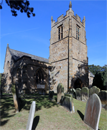 |
Rudby in Cleveland - All Saints |
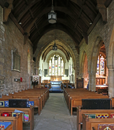 |
| Church open. Park outside |
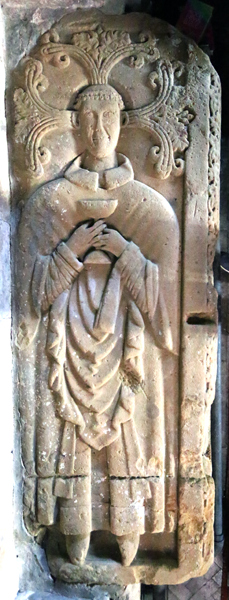 |
 |
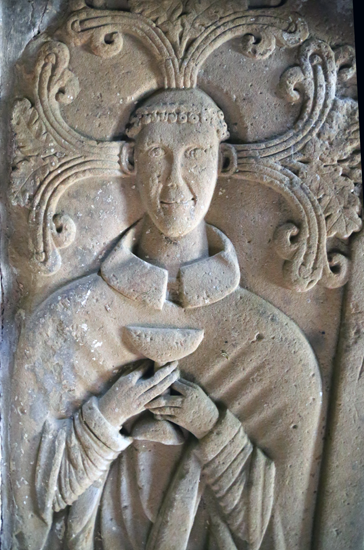 |
|
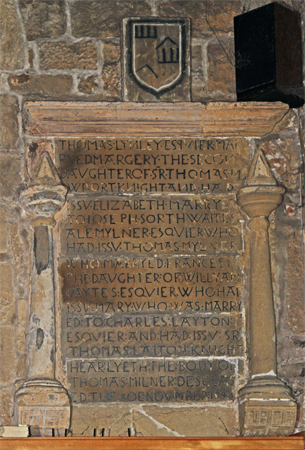 |
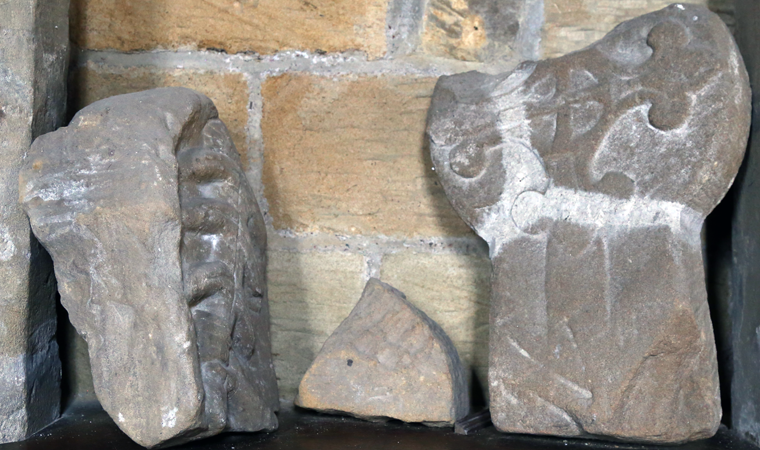 |
||
| Far left, far right,
centre top: Priest, probably early 14th century. Very low
relief. Centre bottom left: Wall monument, 16th century, the text of whihc is given below. It appear to begin with a simple genealogical listing and then records a burial Centre bottom right: Cross fragments. |
|||
THOMAS LYͶLEY ESq MARRYED MARGERY THE SECOͶD DAVGHTER OF S¯R THOMAS NEWPORT KͶIGHT AͶD HAD ISSV ELIZABETH MARRYED TO IOSEPH SORTHEAITSALE MYLNER ESQVIER WHO HAD ISSV THOMAS MYLNER WHO MARRYED FRANCES THE DAVGHTER OF WILLYAM BAYTES ESQVIER WHO HAS ISSV MARY WHO WAS MARRYED TO CHARLES LAYTON ESQVIER AND HAD ISSV SR THOMAS LAITON KNIGHT HEAR LYETH THE BODY OF THOMAS MILNER DESCEASED THE 8 OF NOVMBER 1594 |
| Why These Reversed N's ? |
| Visiting a clinic recently I saw a parking restriction sign painted on the ground with the reversed N's like those shown in the insciption above: Ͷ. In the twenty first century the painter surely knew the alphabet. Bur he used a stencil! And it's easy enough to use the the wrong way round so producing an Ͷ, but very difficult to correct it as the paint is hard to remove. Did the carver perhaps use a stencil to reverse the N's although it seems he sometimes got it right. |
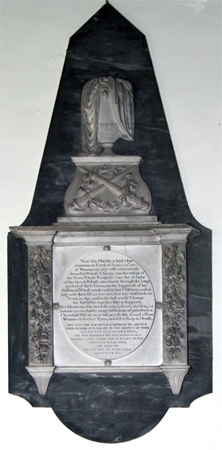 |
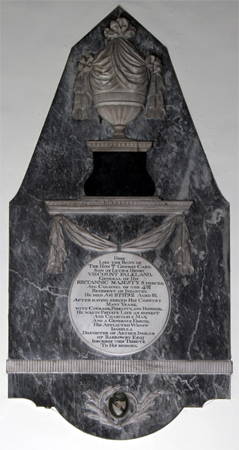 |
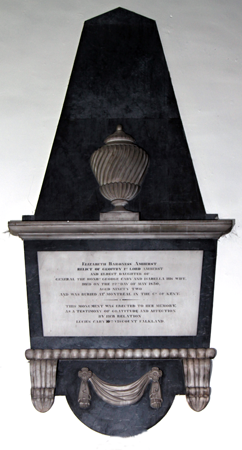 |
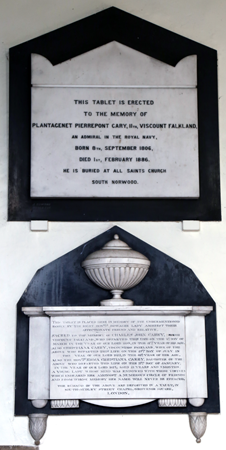 |
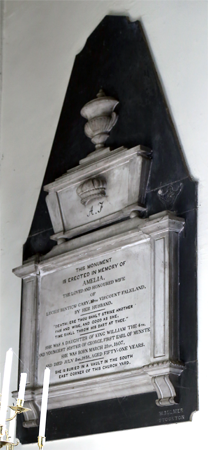 |
| Isabella Cary (Ingram) ( 1799) Wive of Hon George Cary (right) By John Fisher |
The Hon George Cary (1792) Son of Lucius Cary, Viscount Falkland. General and Col 43rd Regiment of Infantry By John Fisher |
Elizabeth Baroness Amherst (1830) Daughter of Gen. The Hon George Cary and Isabella |
Top: Plantagenet Pierrepont
Cary, 11th Viscount Falkland (1886) Admiral RN Buried All Saints, South Norwood Bottom: Charles John Cary, 9th Viscount Falkland (1809) and his wife Christina (1822); Also their daughter, The Hon Emma Christina Cary (1827) Aged 21 All buried in a vault in South Audley St Chapel, Grosvenor Sq. London |
Amerlia Cary Viscountess Falkland
(1858) Wife of the 10th Viscount and daughter of King William IV Buried in a vault in the south east corner of this churchyard |
| Other Monuments |
| Elsa Bessel
Ropner (1908) White tablet in marble frame on black
base with pediment Lucius Cary, 10th Viscount Falkland (1884) White tablet with pediment on similar black base. Buried in Montpellier, France Lucius William Charles Augustus Frederick Cary (1871) Only son of 10th Viscount. Died without issue. Buried at Penshurst, Kent. Again white tablet on black base, both predimented. John Mease (1876) and Hannah (1851) White tablet on black base with curved tops Cpt George Hutton Bowes-Wilson (1915) 4th Batt., Yorkshire Reg. KIA near Ypes. Buried Vlamerltinghe, Belgium |
| St Gregory's Minster |
| The is sometimes (e.g. Pevsner) given as 'Kirkdale'
although there is not only no such village but also no such place
marked on the 1:50 000 Ordnace Survey map. The is however a 'Kirkdale Woods' marked. The Minster is South West of Kirkbymoorside and North of the A170, the trunk road running below the North Yorkshire Moors from Helmsley in the West to Scarborough in the East. It is well signposted. |
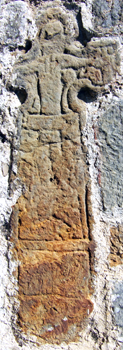 |
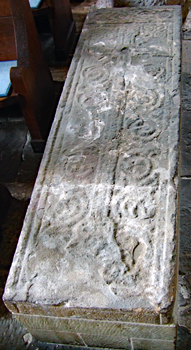 |
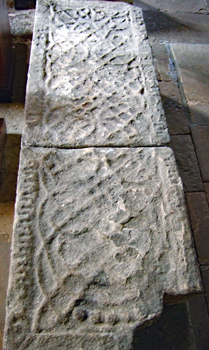 |
| Cross set in wall horizontally | Two Anglo-Saxon coffin lids | |
| There appear to be several wall monument, all minor, and a cartouche but I do not have the photographs | ||
| Scarborough - St Mary |
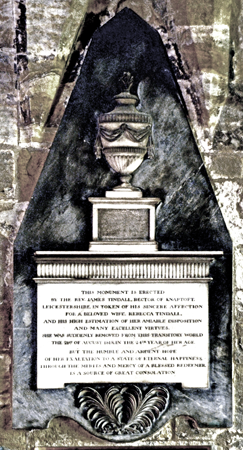 |
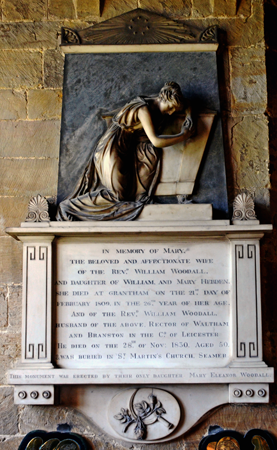 |
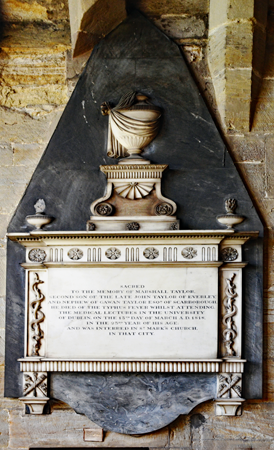 |
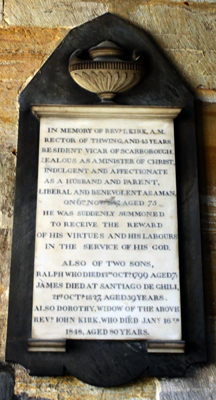 Rev John Kirk AM (1827) Rector of Thwing and Resident Vicar of Scarborough. His sons: Ralph (1799) aged 7; James (1827). His wife, Dorothy (1848) |
| Rebecca Tindall (1818) She was the wife of Rev James Tyndall, Rector of Knaptoft who died at 24 |
Mary Woodhall (Hebden) (26) She died at 26 and was the wife of: Rev William Woodhall (1830) Rector of Waltham and Branston By E V Physick |
Marshall Taylor (1818) He died of typhus fever whilst attending the medical lectures in the University of Dublin aged 23 |
| There is also a
knight which appears in I'Anson's book which is in the museum at
Scarborough. I have not seen it but I will post a copy of
I'Anson's drawing in due course. There are many other tablets and a series of brass plates taken from tomb stones in the church yard |
.png) |
Sheriff Hutton - St Helen and Holy Cross |
.png) |
| Church is open during daylight
hours.
Park in front of church (limited) or nearby in village O/S Ref: SE 658 663 |
.png) |
.png) Above left & below leftt: Said to be Sir Edward Thweng (1444) but armour looks earlier. Above right, below centre & right and drawing below on right: Alabaster (of poor quality, not helped by the poor restoration by filling gaps with polished alabaster) effigy of a boy, often said to be Edward of Middleham (1484), son of Richard III & Anne Neville, and, hence, Yorkist heir to the throne. However modern research says this is unlikely. |
.png) |
.png) |
.png) |
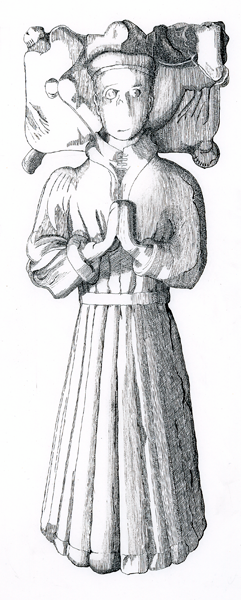 |
.png) |
.png) |
 |
| Mary Hall (1651) '...with their little sonne' | Brass of two babies in swaddling clothes: Dorothy & John Fenys (1491) | Drawing of the knight from I'Anson |
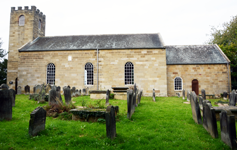 |
Skelton-in-Cleveland - Old All Saint Church |
 |
| This is the Old All Saints Church
which was build in 1787, replacing an earlier medieval church of
which only the chancel north wall remains. It was essentially
'The Squires' Church'. Population growth in the village led to
New Old Saints being built at the end of the village in the
1880's. Regular services in The Old Church ceased in the early
20th century. There was a fire in the Old Church in 1983,
following which it passed into the care of the Churches
Conservation Trust in 1986. Monuments from earlier churches can be seen on the walls and in 'museum' fashion. |
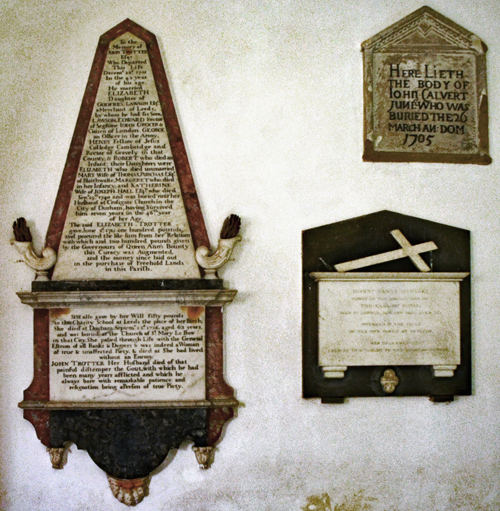 |
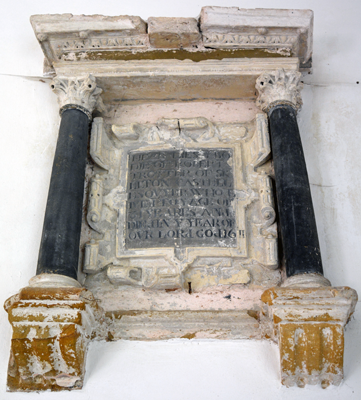 HEAR LIES Y BODIE OF ROBERT TROTTER OF SKELTON CASTELL ESQVYER WHO LIVEd TO Y AGE OF 81 YEARES AND DIEd IN Y YEAR OF OVR LORd GOd 1611 |
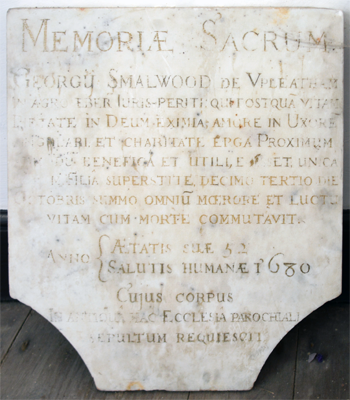 |
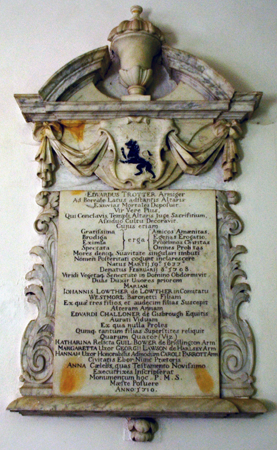 |
|
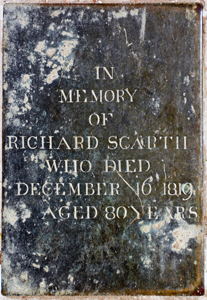 |
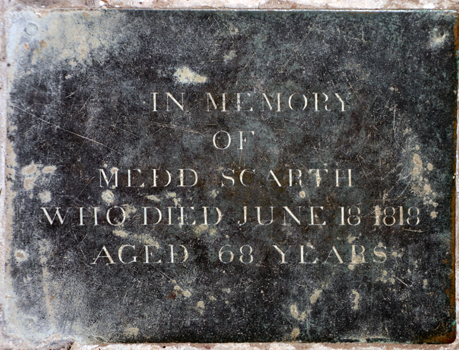 |
|||
| Above, Left:
John
Trotter (1701). Right top:
John
Calvert (1705) Right bottom: Hon Fanny Rawdon (1850) |
Pevsner in Yorkshire, North Riding writes that Skelton Castle appears to be essentially in the castellated state of c. 1800 and the recorded date is c.1794. He also states that there was a 'real' castle here in the 12th century of which there are no now remains. He obviously did not see the monument to Robert Trotter, nor did he record any of them. | Top: George Smalwood of
Upleatham Oct 13th 1680 Marble. Latin text Bottom: Floor slabs: Medd Scarth (1818); Richard Scarth (1818) |
Edward Trotter (1708) | |
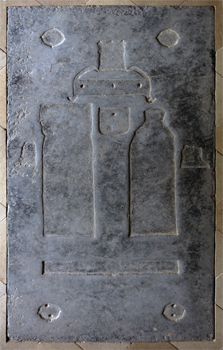 |
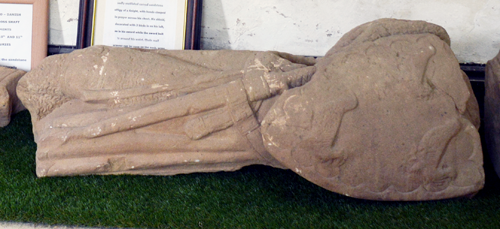 |
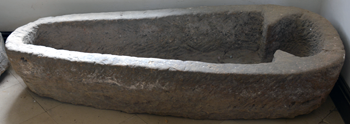  |
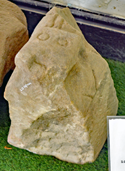 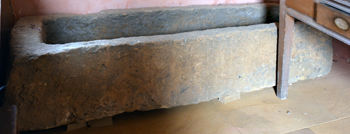 |
| Left: Brass matrix, in position on the floor. Above: Effigy of knight, 14th century. Now headless and legless but fine detail can still be seen. Right: Medieval stone coffin and what is thought to be a Viking child's tomb stone. 10th century. All of these latter items are arranged in 'museum' fashion. |
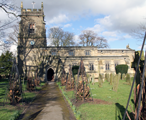 |
Slingsby - All Saints |
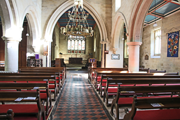 |
| This is a mainly Victorian church but retains a early 14th century knight (holding his heart) and a foliated cross. The church is on the edge of the large village and is open; park outside. O/S Ref: SE 697 751T |
 |
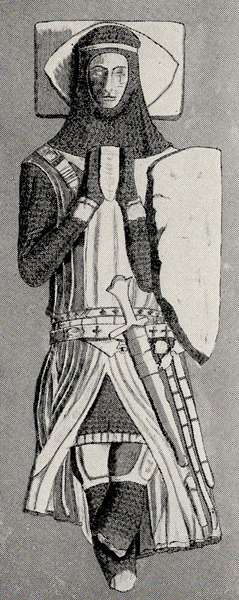 |
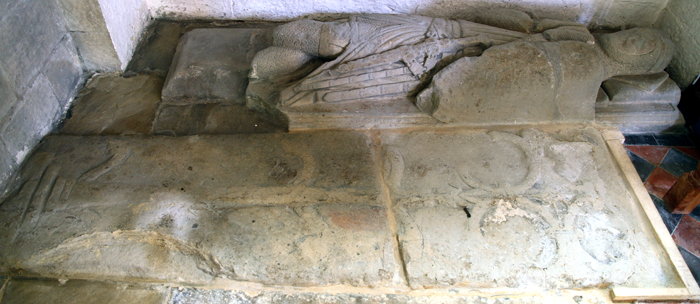 |
|
| Above is the knight presumably from anearlier
church. Below this is the cross with the knight in the
background. One of the Wyville family. To the right is a drawing of the effigy by I'Anson |
|
|
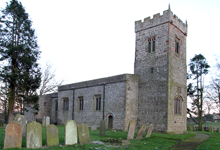 |
South Cowton - St Mary |
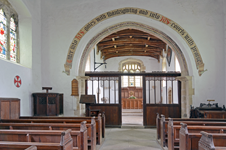 |
| There is no actual village now of South Cowton so you will neither find it on satnav nor map; the church is cared for by the Churches Conservation Trust. From the A1 take the B1263 towards Darlington; on the right you will see a sign 'Atley Fields. Adamson Contractors.' Turn into this road - which is no more than a track - and you will immediately see a wooden sign 'Public Footpath. Historic Church'. Atley Fields is marked on the Ordance Survey map. Follow the track along a water meadow on your right for 800 yards and park outside the church, which is unlocked. If you come to a cross road leading to North Cowton to your left and East Cowton to your right, you have travelled too far towards Darlington. O/S Ref: NZ 293 026 |
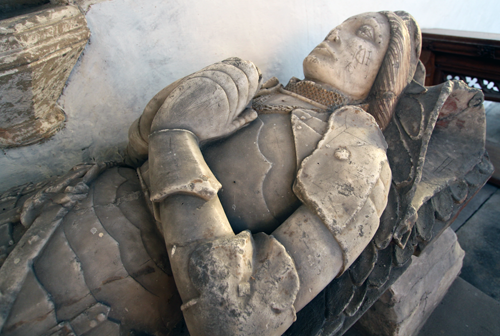 |
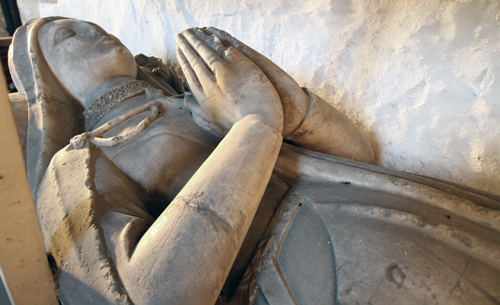 |
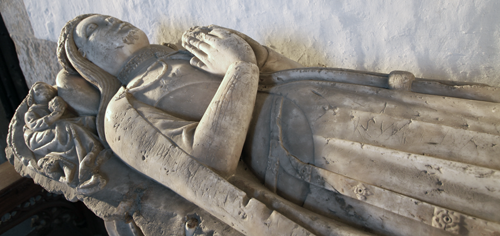 |
 |
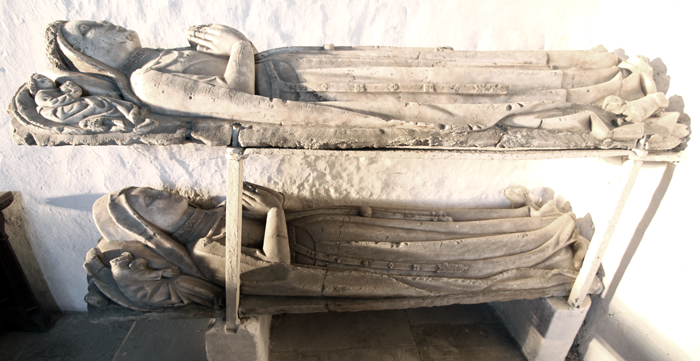 Alabaster effigies of either Sir Richard Boynton (c. 1485) or Sir Richard Conyers (1502) - the latter is more likely - and his two wives, one of whom represents Alice Wycliffe. These effigies are clearly not in situ and almost certainly would have rested side by side on a tomb chest. |
 |
|
 |
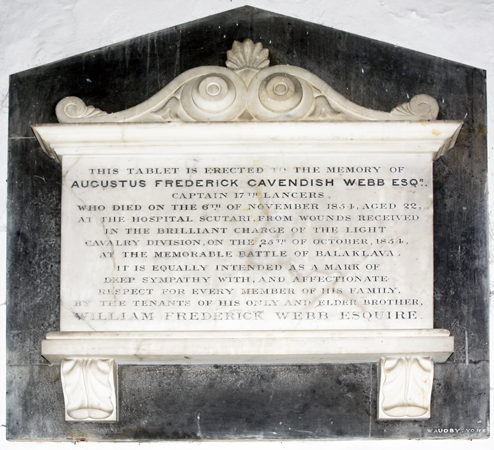 |
 |
| Cpt Augustus Frederick Cavendish Webb (1854) '... from wounds received in the brilliant charge of the light cavalry division...' | Lt Gen Sir Herbert Charles Chermside RE CB GCMG (1929) |
 |
Spennithorpe - St Michael and All Angels |
 |
| Church is open. There is limited parking outside or park in the village. Very friendly church. Toilets inside |
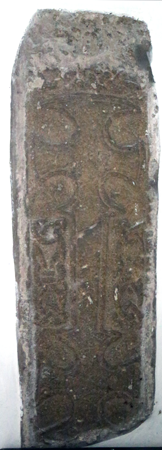 |
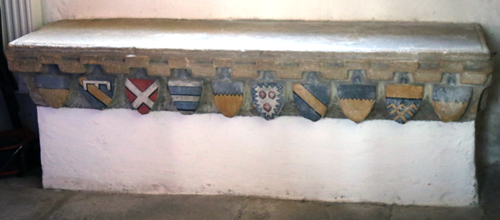 Left: Grave slab with cross 10th century. In locked vestry. Above: Tomb chest ; Fitz-Randall family. Near Right: Francis R Wyville (1684) Rector. Painted wooden board. Mid Right Top: Matthew William Chayter (1825) Mid Right Middle: Charlotte Chaytor (1792) 3rd daughter of William and Jane Chaytor. Aged 14 Also Harriot Chaytor (1798), their youngest daughter. Aged 17. Mid Right Bottom. Jane Chaytor (1811), their eldest daughter. |
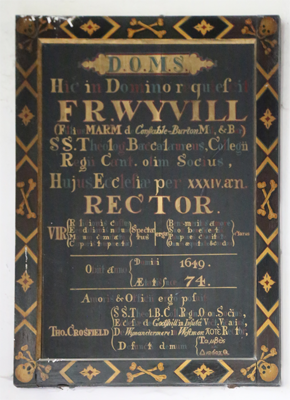 |
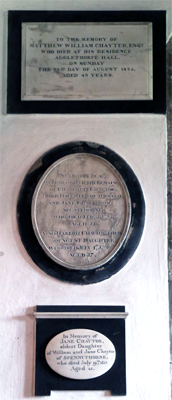 |
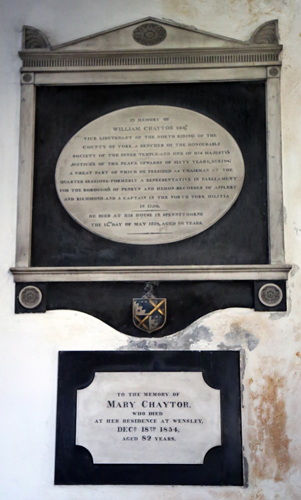 |
| Far
Right Top: William Chaytor (1894) Vice Lt
of the North Riding; Bencher of Inner Temple; JP; MP; Capt.
North York Militia 1759. Far Right Bottom: Mary Chaytor (1854) |
||||
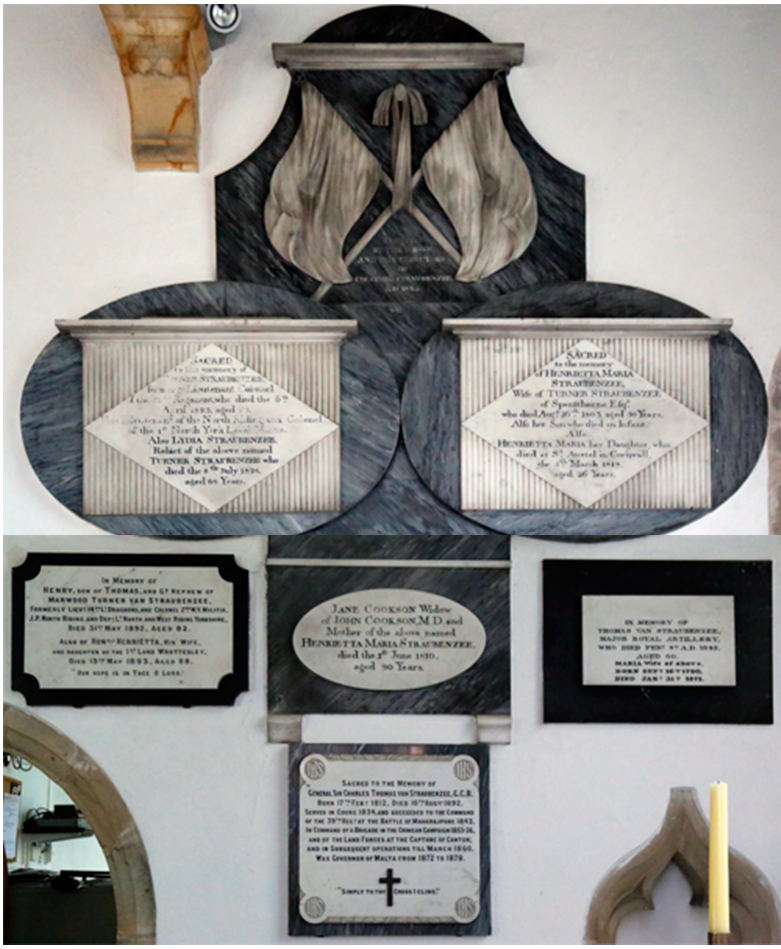 |
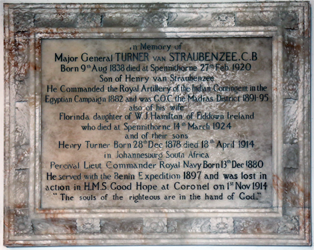 Mjr-Gen Turner van Straubenzee CB (1920) and his wife Florinda (Hamilton (1914). And their sons: Henry Turner (1914) Lt Comm Percival RN (1914) Lost in action in HMS Good Hope at Coround |
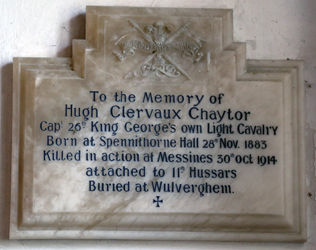 Cpt Hugh Clervaux Chaytor (1915) 26th King George's Own Light Cavalry. KIA Messines attached to 11th Hussars. Buried at Wulverghen |
| Key to the Monuments Above Left | ||
| Erected by the widow and executors of Colonel Straubenzee | ||
| Turner Straubenzee
(1823) Lt. Col 52nd Regiment Vice Lt. North Riding Col of 1st North Yorks Militia Lydia Straubenzee (1825), his wife. |
Henrietta
Maria Straubenzee (1803) Wife of Turner Straubenzee And her infant son Also Henrietta Maria (1818) Her daughter |
|
| Henry (1892), son of Thomas and
grand nephew of Marwood Turner Straubenzee. Lt 14th Dragoons and Col 2nd West Yorkshire Militia JP North Riding and Deputy Lt North and West Riding His wife, Hon Henrietta (1890) |
Jane Cookson (1810) Mother of Henrietta Maria Straubenzee above |
Major Thornton Straubenzee (1843) Royal Artillery His wife Maria (1871) |
| General Sir Charles Thomas Straubenzee CCB (1892) Lists some dervice details including holding command of a brigade in the Crimean Campaign 1855-56; and land forces at the capture of Canton and subsequent operations until 1860. Governor of Malta 1872-78 | ||
| Other Monuments |
| Elizabeth I'Anson (1780), Mary
I'Anson (1782), Thomas I'Anson (1784) Brass Christopher Edward Wyville MA (1893) 23 years rector. Brass Lt Col Rowan van Straubenzee (1898) Served in India, Crimea, China and Canada. Brass Thomas van Straubenzee (1843) and his wife Maria (1871). Brass recording the window above was erected in their memory in 1872. On sill |
| Stanwick - St John the Baptist |
| Under the care of the Churches Conservation Trust |
 |
 Left: Two male civilian and one female medieval effigies Above: Female medieval effigy. All in the chancel |
 |
|
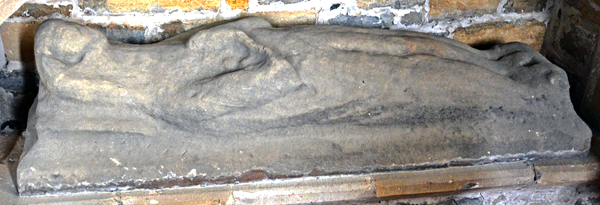 |
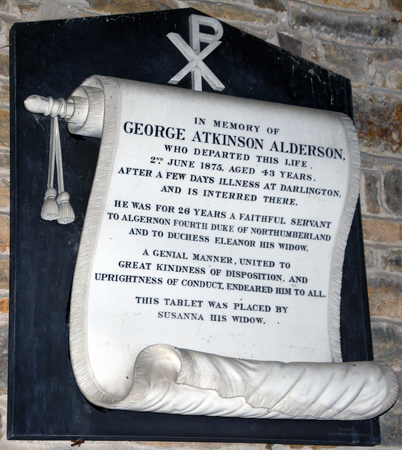 Above: George Atkinson Alderson (1875) Right : Wingate Pulleine (1768); his daughter-in-law, Winifred Pulleine (1782). Below is Elizabeth Pulleine (Button)(1806). Much of the lettering has faded and rendered illegible. Next right: Sir Hugh Smithson 3rd Bart (1729). The monument was erected 1732. |
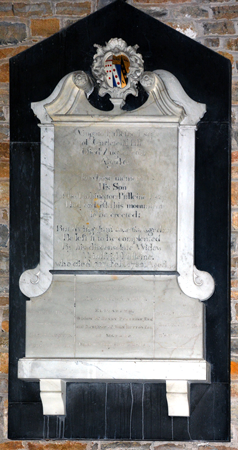 |
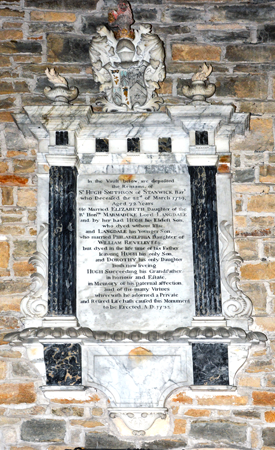 |
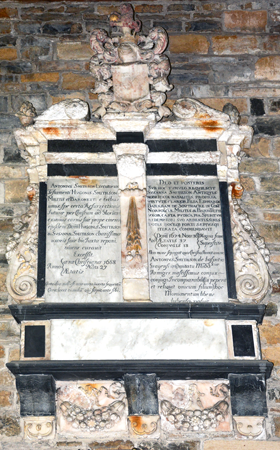 |
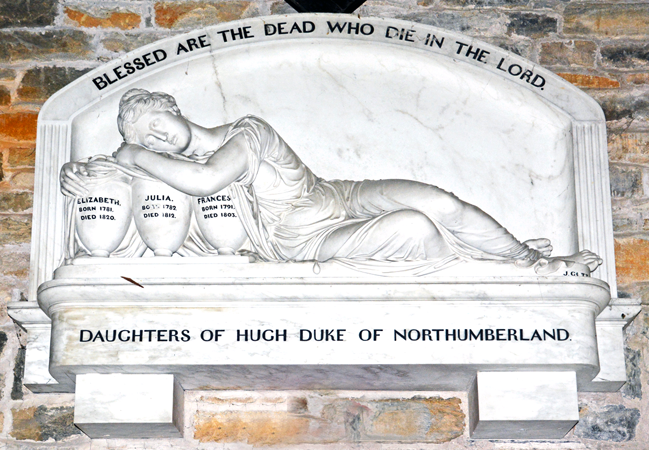 Above: Daughters of Hugh, Duke of Northumberland. By J. Gott Elizabeth (1820), Julia (1812), Frances (1803) Left: Anthony Smithson (1688), son of Sir Hugh, 1st Bart, and his wife, Susannah (Barkham) (1674) |
 |
 Sir Hugh Smithson 1st Bart (1670) and his wife Dorothy (Rawstrone) (1691) Note the effigy of a lady under the window and below the monument; this is shown above. |
 |
| Please note: the information given in Pevsner (The Buildings of England: Yorkshire, The North Riding 1966) is not only rather vague but quite incorrect. I have checked various sources - including the Victoria County History of the area - and read and translated the various texts on the tablets. I believe the information given above is the correct one. |
| There are large number of stones of various type in the church, many set into the wall. I have shown a number of the most interesting below |
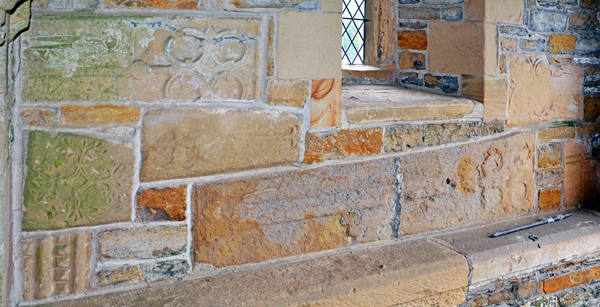 |
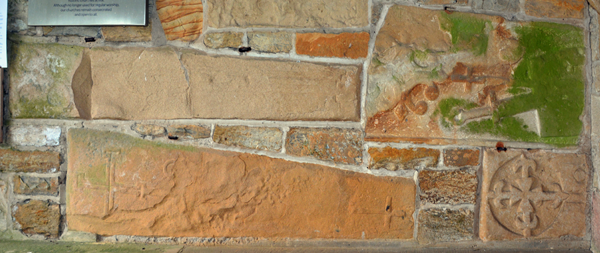 |
| East Wall of the Porch Special Note: Cross and shears (top left); the cross head based on a three circle design appears to be a common feature at Stanwick. Cross with sword (faint) bottom. |
West Wall of the Porch Special Note: The slab on the top right shows a cross, sword and shield; this is the top half, the remaining part being set into the west wall of the south aisle. (shown below) |
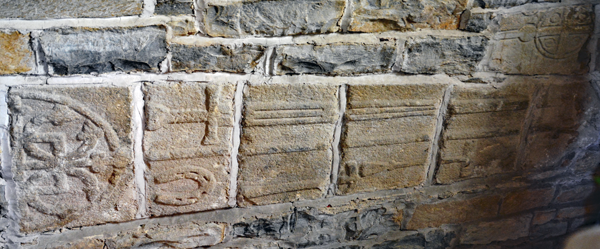 |
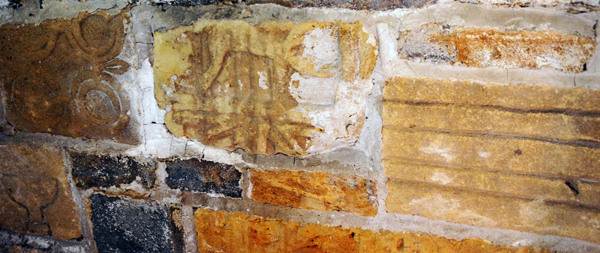 |
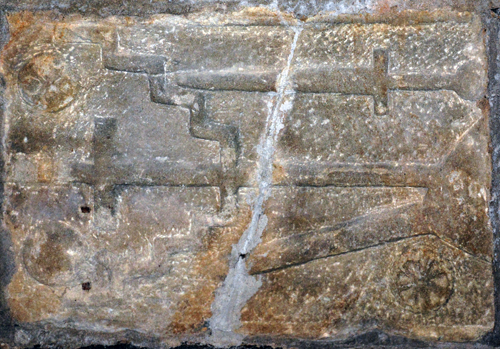 |
| Special Note: A slab of a blacksmith. Note the horse shoe and two types of hammers, as well as the sword. The cross head is partly built from horse shoes, | Special note: The chalice on the fragment bottom left. A slab of a priest. | Special note: The bottom half of the slab shown above; here is the bottom of the sword and shield, as well as a dagger and the base of the cross |
 |
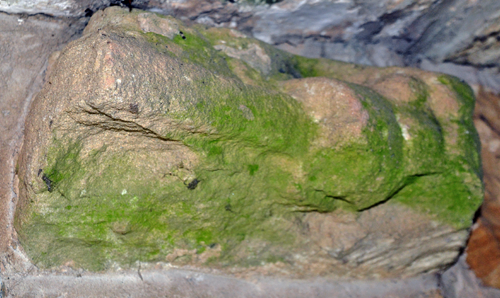 |
| Above: Brass to Eleanor,
Duchess of Northumberland 20th C Right: Fragment of hog back 10th C |
| Stainton - St Peter and St Paul |
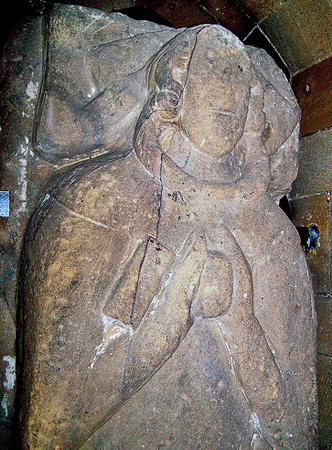 |
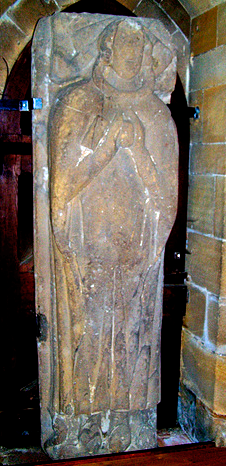 |
| 14th century priest holding a heart |
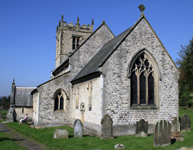 |
Stonegrave - Holy
Trinity (Stonegrave Minster) |
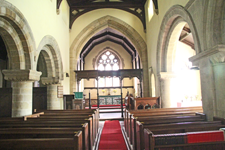 |
| Church open : park in
lane
outside church O/S Ref: SE 656 779 |
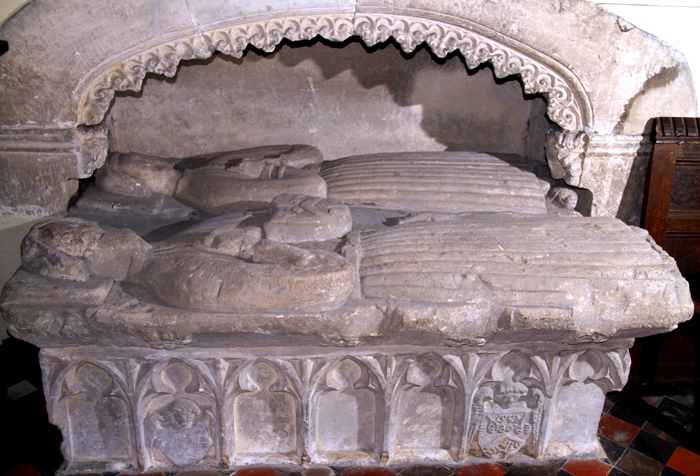 |
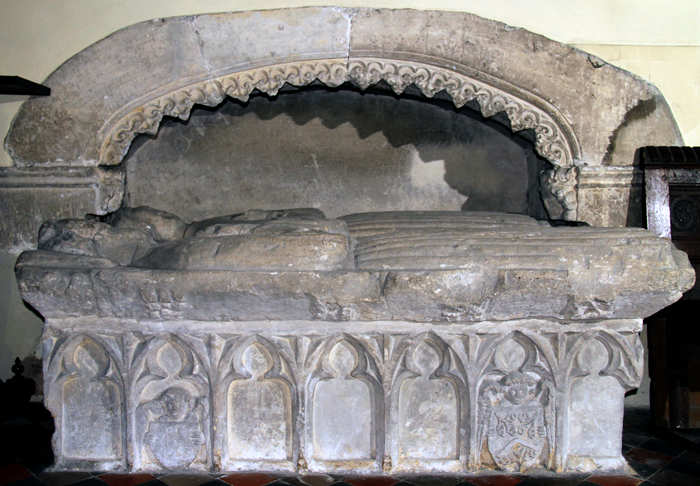 |
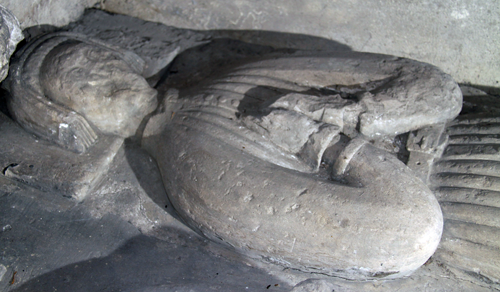 |
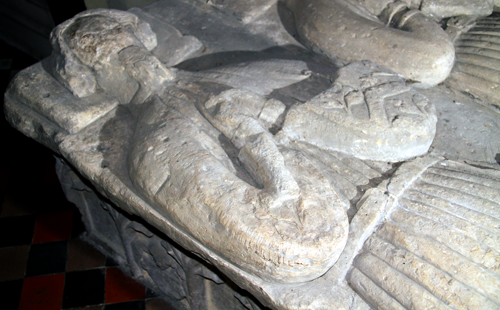 |
|||
|
||||
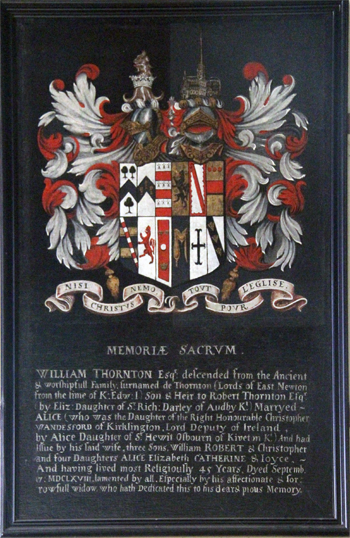 |
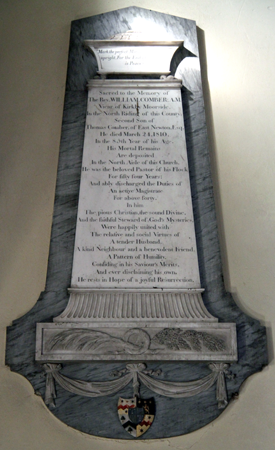 |
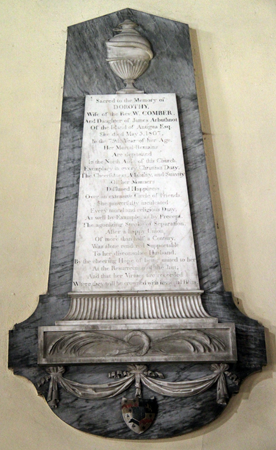 |
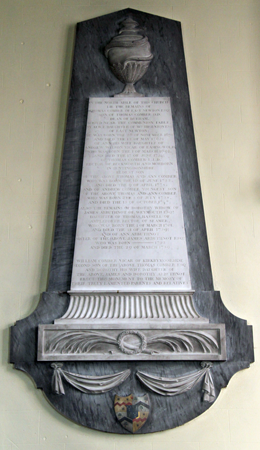 |
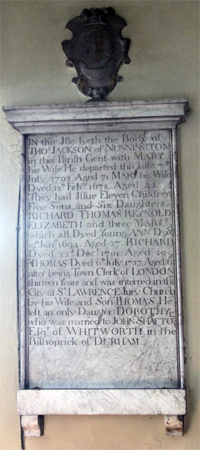 |
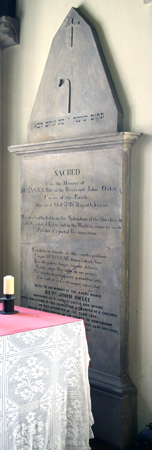 |
| Far left: WILLIAM THORNSTON Esqr deſcended from the Ancient & Worſhipfull Family, ſurnamed de Thornton (Lords of East Newton from the time of K: Edw: 1...Marryed ALICE...And having lived most Religiouſly 45 Years, Dyed Septemb 17 MDCLXVII' Painted wooden panel. Near left: Rev William Comber A.M. (1810) Vicar of Kirky Moorside. Centre left: His wife Dorothy (1807) Centre right: The above set up this tablet to member of their family: To Rev William's father, Thomas (1763), and mother Anne (1734); to his elder brother Rev Thomas LLD (1778), Rector of Beckworth & Morborn in Huntingdonshire; and to his younger brother Andrew (1747). To Dorothy's mother, Dorothy (1759) and to the latter's sister Ann (1789) Near right: 'JN this Jſle lyeth the Body of THOs JACKSON of NUNNUNGTON in this Pariſh Gent with MARY his WIFE...' 1702 & 1678 '...They had Jſſue Eleven Children Five Sons and Six Daughters. RICHARD, THOMAS, REYNOLD, ELIZABETH and three MARYS which all Dyed Young. ANN Dyed 19th Janry 1694 Aged 27. RICHARD Dyed 22d Decr 1701 Aged 29. THOMAS Dyed 6th July 1737 Aged 63 after being Town Clerk of LONDON thirteen YEARS and was interred in the City at St LAWRENCE Jury Church by his Wife and son THOMAS. He left an only Daugter DOROTHY who was married to JOHN SHAFTOE Eſq of WHITWORTH in the Biſhoprick of DURHAM Far right: See below, right. | |||||
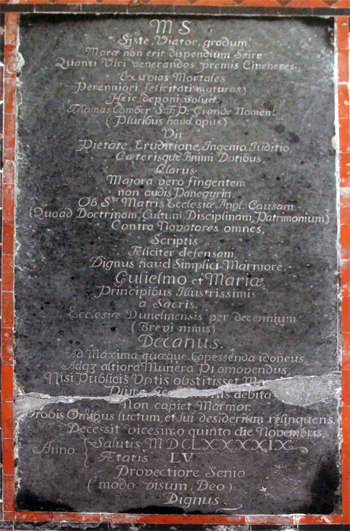 |
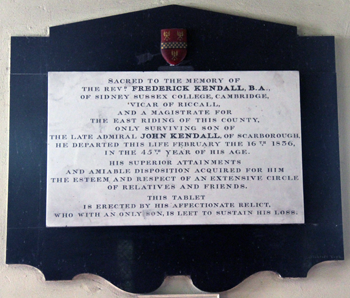  |
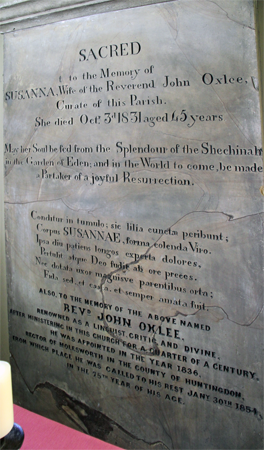 |
| Thomas Comber STP (1699) floor slab, Latin text |
Top: Rev Fredrick Kendall
BA (1836) Vicar of Riccall and a magistrate for
the East Riding of this County. Bottom: |
Susanna Oxlee (1831) and her husband Rev John Oxlee (1854), Curate at Stonegrave. |
| Sutton on the Forest |
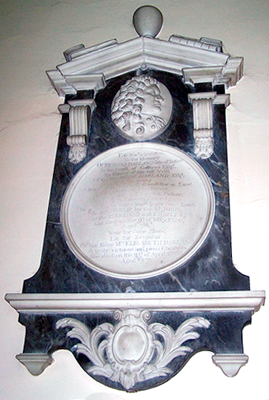 |
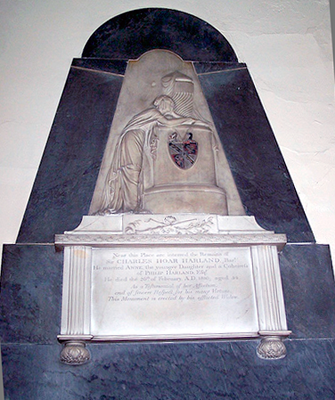 |
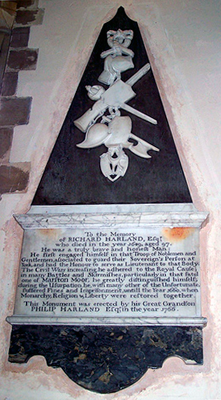 |
| Richard Harland (1750) JP Lawyer of Gray's Inn |
Sir Charles Hoar Harland (1810) He added Harland to his name after marrying Anne, co-heiress of Philip Harland |
Richard Harland (1689) fought for the Royalists at Marston Moor and Worcester |
